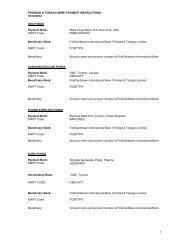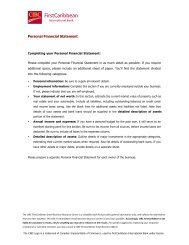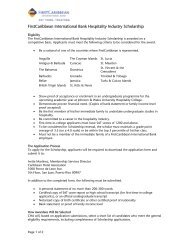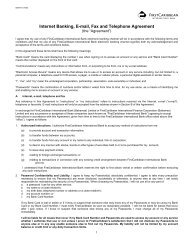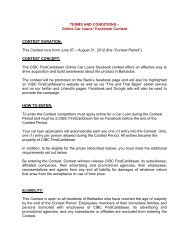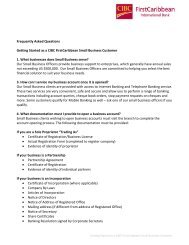(Jamaica) Limited - FirstCaribbean International Bank
(Jamaica) Limited - FirstCaribbean International Bank
(Jamaica) Limited - FirstCaribbean International Bank
You also want an ePaper? Increase the reach of your titles
YUMPU automatically turns print PDFs into web optimized ePapers that Google loves.
notes to the Financial Statements<br />
Year Ended 31 October 2009<br />
(Expressed in <strong>Jamaica</strong>n dollars unless otherwise indicated)<br />
2. Summary of Significant Accounting Policies (Continued)<br />
(g) Financial assets (continued)<br />
All purchases and sales of financial assets that require delivery within the time frame established by regulation or<br />
market convention (“regular way” purchases and sales) are recognised at trade date, which is the date that the<br />
Group commits to purchase or sell the asset. Otherwise such transactions are treated as derivatives until settlement<br />
occurs. Loans and receivables are recognised when cash is advanced to borrowers.<br />
Financial assets are initially recognised at fair value plus transaction costs for all financial assets not carried at fair value<br />
through profit or loss.<br />
Available-for-sale financial assets are subsequently re-measured at fair value based on quoted bid prices or amounts<br />
derived from cash flow models. Unrealised gains and losses arising from changes in the fair value of securities<br />
classified as available-for-sale are recognised in equity. When the securities are disposed of or impaired, the related<br />
accumulated fair value adjustments are included in the statement of income as gains and losses from investment<br />
securities.<br />
Loans and receivables investments are carried at amortised cost using the effective interest yield method, less any<br />
provision for impairment. Third party expenses associated with loans and receivables, such as legal fees incurred in<br />
securing a loan are expensed as incurred.<br />
Unquoted equity instruments for which fair values cannot be measured reliably are recognised at cost less<br />
impairment.<br />
(h) Offsetting financial instruments<br />
Financial assets and liabilities are offset and the net amount reported in the balance sheet when there is a legally<br />
enforceable right to offset the recognised amounts and there is an intention to settle on a net basis, or realise the<br />
asset and settle the liability simultaneously<br />
(i) Impairment of financial assets<br />
The Group assesses at each balance sheet date whether there is objective evidence that a financial asset or group<br />
of financial assets is impaired. A financial asset or a group of financial assets is impaired and impairment losses are<br />
incurred if, and only if, there is objective evidence of impairment as a result of one or more events that occurred<br />
after the initial recognition of the asset (a ‘loss event’) and that loss event (or events) has an impact on the future<br />
cash flows of the financial asset or group of financial assets that can be reliably estimated. Objective evidence that<br />
a financial asset or group of financial assets is impaired includes observable data that comes to the attention of the<br />
Group about the following loss events:<br />
(i) significant financial difficulty of the issuer or obligor;<br />
(ii) a breach of contract, such as a default or delinquency in interest or principal payments;<br />
(iii) the Group granting to a borrower, for economic or legal reasons relating to the borrower’s financial difficulty,<br />
a concession that the lender would not otherwise consider;<br />
(iv) it becoming probable that the borrower will enter bankruptcy or other financial reorganisation;<br />
(v) the disappearance of an active market for that financial asset because of financial difficulties; or<br />
(vi) observable data indicating that there is a measurable decrease in the estimated future cash flows from a group<br />
of financial assets since the initial recognition of those assets, although the decrease cannot yet be identified<br />
with the individual financial assets in the group, including:<br />
- adverse changes in the payment status of borrowers in the group; or<br />
- national or local economic conditions that correlate with default on the assets in the group.<br />
If there is objective evidence that an impairment loss on loans and receivables carried at amortised cost has<br />
been incurred, the amount of the loss is measured as the difference between the carrying amount and the<br />
recoverable amount, being the estimated present value of expected cash flows, including amounts recoverable<br />
from guarantees and collateral, discounted based on the current effective interest rate.<br />
33



